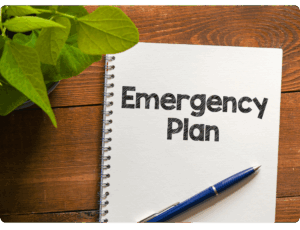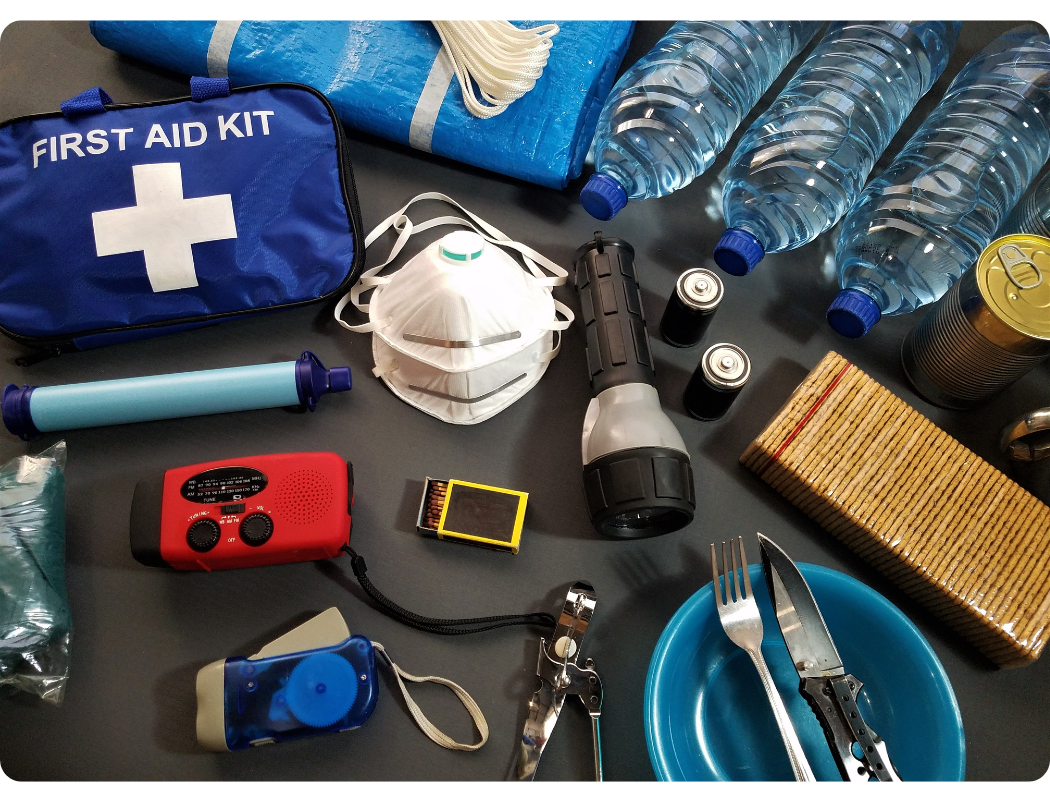 When planning or creating an emergency/ disaster plan, it is important to know that hazards our area is at risk of. These risk have been identified in Franklin County’s Comprehensive Emergency Management Plan. To read the basic plan click the link below:
When planning or creating an emergency/ disaster plan, it is important to know that hazards our area is at risk of. These risk have been identified in Franklin County’s Comprehensive Emergency Management Plan. To read the basic plan click the link below:
Franklin County CEMP Base Plan 2024
Franklin County CEMP Executed Resolution
City of Carrabelle CEMP Resolution
City Of Apalachicola CEMP Resolution
Emergency Planning Resources:
- Franklin County Evacuation Route Map
- FEMA Flood Risk Map
- FEMA Flood Map Center
- Shelter Locations
- Disaster Survival Guide 2025
- Eastpoint to Carrabelle Through Tate’s Hell Map
- Tate’s Hell State Forest Map
Making an Emergency Plan:
⇒ Step 1: Put a plan together by discussing the questions below with your family, friends or household to start your emergency plan.
- How will I receive emergency alerts and warnings?
- Have we signed up for Alert Franklin?
- What is my shelter plan?
- What is my evacuation route?
- What is my family/household communication plan?
- Do I need to update my emergency preparedness kit?
⇒ Step 2: Consider specific needs in your household.
As you prepare your plan, tailor your plans and supplies to your specific daily living needs and responsibilities. Discuss your needs and responsibilities and how people in the network can assist each other with communication, care of children, business, pets or specific needs like operating medical equipment. Create your own personal network for specific areas where you need assistance. Keep in mind some these factors when developing your plan:
- Different ages of members within your household
- Responsibilities for assisting others
- Locations frequented
- Dietary needs
- Medical needs including prescriptions and equipment
- Disabilities or access and functional needs including devices and equipment
- Languages spoken
- Cultural and religious considerations
- Pets or service animals
- Households with school-aged children
⇒ Step 3: Create a Family Emergency Plan
Make a Family Emergency Plan quickly and easily with this fillable form.
⇒ Step 4: Practice your plan with your family/household
Disaster Supply Kit
After an emergency, you may need to survive on your own for several days. Being prepared means having your own food, water and other supplies to last for several days. A disaster supplies kit is a collection of basic items your household may need in the event of an emergency.
The Basic Essentials:
- Water (one gallon per person per day for several days, for drinking and sanitation)
- Food (at least a several-day supply of non-perishable food)
- Battery-powered or hand crank radio and a NOAA Weather Radio with tone alert
- Flashlight
- First aid kit
- Extra batteries
- Whistle (to signal for help)
- Dust mask (to help filter contaminated air)
- Plastic sheeting and duct tape (to shelter in place)
- Moist towelettes, garbage bags and plastic ties (for personal sanitation)
- Wrench or pliers (to turn off utilities)
- Manual can opener (for food)
- Local maps
- Cell phone with chargers and a backup battery
- Blankets/ Sleeping bags
- Medications
- Important documents (i.e. Driver’s License, Insurance Papers, Emergency Contacts, Property Documents, etc.)
- Cash
Additional Items to Consider:
- Soap, hand sanitizer and disinfecting wipes to disinfect surfaces
- Infant formula, bottles, diapers, wipes and diaper rash cream
- Pet food and extra water for your pet
- Complete change of clothing appropriate for your climate and sturdy shoes
- Fire extinguisher
- Matches in a waterproof container
- Feminine supplies and personal hygiene items (i.e. toothbrush, toothpaste, shampoo. etc.)
- Mess kits, paper cups, plates, paper towels and plastic utensils
- Paper and pencil
- Books, games, puzzles or other activities for children
The Items listed here are important to have be may not cover all needs for your specific household. When making a kit consider the unique need of your household.
Pet Emergency Plan and Kits
If you have a plan in place for you and your pets, you will likely encounter less difficulty, stress and worry when you need to make a decision during an emergency. If local officials ask you to evacuate, that means your pet should evacuate too. If you leave your pets behind, they may end up lost, injured or worse, this can be deemed animal neglect and/or animal cruelty.
Things to include in your plan:
- Have an evacuation plan for your pet. Not all public shelters and hotels allow pets inside. Know a safe place where you can take your pets before disasters and emergencies happen.
- Develop a buddy system. Plan with neighbors, friends or relatives to make sure that someone is available to care for or evacuate your pets if you are unable to do so.
- Have your pet microchipped. Make sure to keep your address and phone number up-to-date and include contact information for an emergency contact outside of your immediate area.
Considerations for Large Animals:
If you have pets such as horses, goats or pigs on your property, be sure to prepare before a disaster.
- Ensure all animals have some form of identification.
- Evacuate animals earlier, whenever possible. Map out primary and secondary routes in advance.
- Make available vehicles and trailers needed for transporting and supporting each type of animal. Also make available experienced handlers and drivers.
- Ensure destinations have food, water, veterinary care and handling equipment.
- If evacuation is not possible, animal owners must decide whether to move large animals to a barn or turn them loose outside.
Building Your Pet’s Kit:
Just as you do with your family’s emergency supply kit, think first about the basics for survival, such as food and water. Have two kits, one larger kit if you are sheltering in place and one lightweight version for if you need to evacuate. Review your kits regularly to ensure that their contents, especially foods and medicines, are fresh.
Here are some items you may want to include in an emergency kit for your pet:
- Food. Keep several days’ supply of food in an airtight, waterproof container.
- Water. Store a water bowl and several days’ supply of water.
- Medicine. Keep an extra supply of the medicine your pet takes on a regular basis in a waterproof container.
- First aid kit. Talk to your veterinarian about what is most appropriate for your pet’s emergency medical needs.
- Collar with ID tag and a harness or leash. Include a backup leash, collar and ID tag. Have copies of your pet’s registration information and other relevant documents in a waterproof container and available electronically.
- Traveling bag, crate or sturdy carrier, ideally one for each pet.
- Grooming items. Pet shampoo, conditioner and other items, in case your pet needs some cleaning up.
- Sanitation needs. Include pet litter and litter box (if appropriate), newspapers, paper towels, plastic trash bags and household chlorine bleach to provide for your pet’s sanitation needs.
- A picture of you and your pet together. If you become separated from your pet during an emergency, a picture of you and your pet together will help you document ownership and allow others to assist you in identifying your pet.
- Familiar items. Put favorite toys, treats or bedding in your kit. Familiar items can help reduce stress for your pet
Guide to Help with Pet Planning:
Pet Resource Guide
Shelter Planning
Sheltering is appropriate when conditions require that you seek protection in your home, where you work or other location when other emergencies arise. The length of time you are required to take shelter may be short, such as during a tornado warning, or during a pandemic. In all cases, it is important that you stay informed and follow the instructions of local authorities.
Mass Care Shelter
Mass care shelters provide life sustaining services to disaster survivors. Even though mass care shelters often provide water, food, medicine and basic sanitary facilities, you should plan to take your emergency supply kit with you so you will have the supplies you need. Mass care sheltering can involve living with many people in a confined space, which can be difficult and unpleasant.
- Be prepared to take cleaning items with you like, soap, hand sanitizer, disinfecting wipes or general household cleaning supplies to disinfect surfaces.
- All shelters accept service animals, but many public shelters and hotels do not allow pets inside. Know a safe place where you can take your pets before disasters and emergencies happen.
Sheltering in Place
Whether you are at home, work or anywhere else you frequent regularly, there may be situations when it’s best to stay where you are and avoid any uncertainty outside.
Here are some indicators and steps to take if the situation arises:
- Use common sense and available information to assess the situation and determine if there is immediate danger.
- If you see large amounts of debris in the air, or if local authorities say the air is badly contaminated you may want to take this kind of action.
Here are some tips for sheltering in place:
- Local authorities may not immediately be able to provide information on what is happening and what you should do.
- Pay attention to local media outlets for official news and instructions as they become available.
- Bring your family and pets inside.
- Lock doors, close windows, air vents and fireplace dampers.
- Turn off fans, air conditioning and forced air heating systems.
- Take your emergency supply kit unless you have reason to believe it has been contaminated.
- Go into an interior room with few windows if possible.
- Seal all windows, doors and air vents with thick plastic sheeting and duct tape. Consider measuring and cutting the sheeting in advance to save time.
- Cut the plastic sheeting several inches wider than the openings and label each sheet.
- Duct tape plastic at corners first and then tape down all edges.
- Be prepared to improvise and use what you have on hand to seal gaps so that you create a barrier between yourself and any contamination.
“Sealing a room” is considered a temporary protective measure to create a barrier between you and potentially contaminated air outside. This type of sheltering in place requires pre-planning, by purchasing plastic sheeting and duct tape that you would keep in your emergency supply kit.

